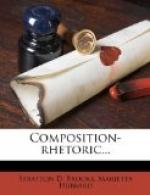Streams are the easiest routes of travel and commerce. A river usually furnishes from its mouth well up toward its source a smooth, graded highway, upon which a cargo may be transported with much less effort than overland. If obstructions occur in the form of rapids or falls, boat and cargo are carried around them. It is often easy to pass by a short portage or “carry” from one stream system across the divide to another. In regions which are not very level the easiest grades in every direction are found along the streams, and the main routes of land travel follow the stream valleys. In traversing a mountainous region, a railroad follows the windings of some river up to the crest of the divide, which it crosses through a pass, or often by a tunnel, and descends the valley of some stream on the other side.
Man is largely indebted to streams for the variety and beauty of scenery. Running water itself is attractive to young and old. A landscape without water lacks its chief charm. A child instinctively finds its way to the brook, and the man seeks beside the river the pleasure and recreation which no other place affords. Streams have carved the surface of the land into an endless variety of beautiful forms, and a land where stream valleys are few or shallow is monotonous and tiresome. The most common as well as the most celebrated beauty of scenery in the world, from the tiny meanders of a meadow brook to the unequaled grandeur of the Colorado canyons, is largely due to the presence and action of streams.
—Dryer: Lessons in Physical Geography.
In the above selection we find that each group of sentences is related to some main topic. A more extended observation of good writing will give the same result. Men naturally think in sentence groups. A group of sentences related to each other and to the central idea is called a +paragraph.+
+38. Topic Statement.+—In the three paragraphs of the selection on page 67, notice that the first sentence in each tells what the paragraph is about. In a well-written paragraph it is possible to select the phrase or sentence that states the main thought. If such a sentence does not occur in the paragraph itself, one can be framed that will express clearly and concisely the chief idea of the paragraph. This brief, comprehensive summary of the contents of a paragraph is called the topic statement.
In order to master the thought of what we read we must be able to select or to make the successive topic statements, and in order to express our own thoughts clearly we must write our paragraphs so that our readers may easily grasp the topic statement of each.
When expressed in the paragraph, the topic statement may be a part of a sentence, a whole sentence, or it may extend through two sentences. It is usual to place the topic statement first, but it may be preceded by one or more introductory sentences, or even withheld until the end of the paragraph. For emphasis it may be repeated, though usually in a slightly different form.




